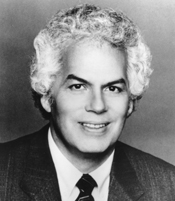Stanley B. Prusiner, M.D.

Brief Bio
Stanley Ben Prusiner was born in Des Moines, Iowa, on May 28, 1942, but grew up in Sioux City, Iowa, and Cincinnati, Ohio. While an undergraduate at the University of Pennsylvania, he participated in a research project on hypothermia with Sidney Wolfson, an experience that kept him at the University of Pennsylvania Medical Center, where he received his M.D. in 1968. After graduation, he spent three years in Earl Stadtman's laboratory at the National Institutes of Health studying glutaminases in
Escherichia coli, an experience he recognizes as "critical in my scientific education." In 1972, Prusiner began a residency at UCSF in the Department of Neurology, where he admitted a patient with Creutzfeldt-Jakob disease (CJD); it was his fascination with her case that led him to the research into the "slow virus" assumed to be causing her death. For his CJD research, he was named a Howard Hughes Medical Institute investigator from 1976 to 1981.
Nobel Prize in Physiology or Medicine
1997 Nobel Prize in Physiology or Medicine “for his discovery of Prions – a new biological principle of infection.”
Lasker Award
1994 Albert Lasker Basic Medical Research Award “for landmark, revolutionary work that established the existence of an entirely new class of infectious agents, and which opened new understanding of the pathogenesis of several baffling neurodegenerative diseases.”
Click here for more details.
AAI Service History
Joined: 1981
Nobel Prize in Science
Stanley B. Prusiner, Institute of Neurodegenerative Diseases at the University of California, San Francisco (UCSF), received the 1997 Nobel Prize in Physiology or Medicine for his discovery of "prions," adding a new class of infectious agents to the known list of bacteria, viruses, fungi, and parasites. An acronym he derived from "proteinaceous infectious particles," prions are pure proteins devoid of DNA and RNA, known to exist normally as innocuous cellular proteins. The Nobel Assembly hailed Prusiner's discovery of the capacity of these proteins to convert their structures into "conformations that ultimately result in the formation of harmful particles, the causative agents of several deadly brain diseases of the dementia type in humans and animals."
Prusiner discovered prions while investigating transmissible spongiform encephalopathies, including scrapie and Creutzfeldt-Jakob disease (CJD). In 1982, after ten years of research, he and his team produced a preparation from a hamster brain that contained an infectious agent comprised of only a single protein. Prion proteins (PrP), Prusiner found, were "double agents," existing in both a normal conformation (PrPc) and a disease-causing conformation (PrPSc). The latter could lie in wait, incubating for long periods before initiating a chain reaction converting the normal PrPc protein into the disease-causing PrPSc conformation, resulting in destruction of brain tissue. For a decade, Prusiner had anticipated finding that the purified scrapie agent would be a small virus. His data, however, did not support the hypothesis. They told him only that his preparations contained protein but not nucleic acid. These were trying times for Prusiner. Tenure at UCSF was at stake, and the Howard Hughes Medical Institute had informed him that his funding would not be renewed. The publication of his groundbreaking 1982 Science article, however, salvaged tenure and the opportunity to continue his work.
When Prusiner published his findings in 1982, his work was said to have caused a firestorm in the scientific community. Virologists were generally incredulous, and scientists working on scrapie and CJD were staking their careers on finding the nucleic acid of the putative "scrapie virus." Prusiner credits the controversy for the vigor with which he undertook research to detect the presence of nucleic acid that would contradict his findings of prions. None was found.
Even after Prusiner received the Nobel Prize, prions continued to prompt a great deal of debate as skeptics denied the existence of infectious agents that had no trace of genetic material. Prusiner continued to make the case for prions, however. In 2004, he and his team made significant headway in quieting his critics by identifying prions' role in the spread of bovine spongiform encephalopathy, commonly known as mad cow disease.
In addition to continuing his own research activities, Prusiner helped establish a 400,000 square-foot neuroscience building at UCSF Mission Bay, dedicated to bringing scientists together from all over the world to study neurological disorders, including Parkinson's, Alzheimer's, epilepsy, and CJD.
"People often ask me why I persisted in doing research on a subject that was so controversial," said Prusiner in his Nobel acceptance speech. "I frequently respond by telling them that only a few scientists are granted the great fortune to pursue topics that are so new and different that only a small number of people can grasp the meaning of such discoveries initially."
Prusiner's work has been extensively praised by others. "The work of Dr. Prusiner has led to more knowledge about prion diseases than any other form of neurodegeneration," said Jeffrey Bluestone (AAI '82), UCSF executive vice chancellor and provost. "But, as importantly, these discoveries have forged a new understanding of neurodegenerative disease processes that will lead to new treatments for devastating diseases such as Alzheimer's and Parkinson's."
Awards and Honors
- Member, National Academy of Sciences, 1992
- Member, Institute of Medicine, 1992
- Member, American Academy of Arts and Sciences, 1993
- Albert Lasker Basic Medical Research Award, 1994
- Wolf Prize in Medicine, 1996
- Foreign member of the Royal Society, 1997
- Nobel Prize in Physiology or Medicine, 1997
- Member, American Philosophical Society, 1998
- National Medal of Science, 2010
Institutional/Biographical Links
- Institute for Neurodegenerative Diseases, University of California, San Francisco, faculty page
- Nobel Prize biography